
HoofHearted
Community Member-
Posts
1,024 -
Joined
-
Last visited
Content Type
Gallery
Profiles
Forums
Events
Everything posted by HoofHearted
-
I don't think you'll see as much vertical passing game from us this year. To me it looks like they want to use pre-snap movement to set up quick hitters more in line with what we saw towards the end of last season. Probably will see a lot more screen game and RPO game this year. Any mesh action between a QB/RB is going to force the defense to, at the very least, stop their feet. Even on true under center play action no one is teaching linebackers to fly downhill anymore until they see ball given. There's too much offenses are doing now to take advantage of that. Works vs zone quite well too. That's why its a staple in essentially every offense. See man throw the mesh. See zone throw the OTB.
-
Yeah, that’s kind of the nature of it isn’t it. Playing on the edge like that can be very boom or bust. I think what encourages me, even on the plays that didn’t go our way, the design of the scheme was excellent. You could clearly see we were being deliberate with our pressures - not sending guys just to send them - but scheming up protections in order to guarantee someone free or at the worst 1v1 with a RB. Having personally been in those shoes before I can tell you exactly where those calls are coming from haha. When you’re not getting home with four and just leaving your secondary out to dry your next answer is to start bringing more.
-
There's been enough discussion around here about schemes and concepts that we all do not want to see again. With new Coordinators on both sides of the ball, what schemes and concepts from last year would you like to see carry over into this season under new leadership? Personally I'd like for us to continue building on our Dart run concept that was so successful for us last season (click here if you're unfamiliar with the concept). It was by far our most productive run concept we ran, and towards the end of the year I think we got a bit of a glimpse of what's to come this season under Brady as we saw an uptick in the RPO game off of Dart action. My hope is we'll continue to scheme around this concept in order to not only have Dart, Q Dart, and all of the RPO game off of it, but also be able to use the blocking scheme in misdirection off jet/orbit motions. Defensively we saw a dramatic shift in our coverages going from a primarily Quarters/Cover 2 defense with a steady dose of Cover 3 mixed in to a predominantly Cover 3/Cover 1 defense with a steady dose of Quarters mixed in. With the backers we've been able to add to the team over the last few seasons I think we're at a point where we can feel comfortable sitting in Cover 1 knowing that our guys are athletic enough to get home on pressures. My hope is we continue to lean into this, put pressure on opposing Quarterbacks while still being able to disguise these looks as Cover 3 or Quarters coverages to give help to our secondary.
- 66 replies
-
- 16
-

-

-

-

-
Generally speaking a post vs. any middle open coverage is dream scenario. It's fairly easy to manipulate Safety hips with the stem of the route to get them to open outside before you cut back in. Once you win leverage there's no one else there since the backside Safeties eyes will never look there - becomes a foot race in the end.
-
Any Chance of Playing Some 4- 3 Next Year?
HoofHearted replied to st pete gogolak's topic in The Stadium Wall
Which is why we base out of Nickel. -
Any Chance of Playing Some 4- 3 Next Year?
HoofHearted replied to st pete gogolak's topic in The Stadium Wall
We do. Anything 12p or heavier we bring in more backers. -
PFF grades are for fans. They serve no purpose to teams.
-
Is that a broadcast angle? The angle is not the same as what I'm watching on the A22 that clearly shows the corner playing outside leverage.
-
Wouldn't let me post two images in the same post, but here's your post-snap (still outside leverage) look. As far as the route being an option route - like I said you don't run out-breaking routes that close to the goal line on the backside of a progression. On top of that - everything in Gabe's movement indicates he's running a called route concept. It very well could have been a pre-snap option based on pre-snap leverage, and based on that pre-snap leverage he ran the correct route, but there is definitely no post-snap option route being run here.
-
-
Without going back and looking at every play I couldn't say.
-
Davis gets pre-snap outside leverage and post-snap outside leverage by the corner. The screenshot Einstein posted makes it look otherwise, but it's only because the corner plays catch technique on Davis. The corners head is behind the receiver, but he still has front-side control. I said this in another thread, but will say it again here - Gabe's not running an option route here. The whole concept of the option is to avoid defenders and run to space - that's not what happened on this play. Gabe was leaning into the DB to make him work further outside before cutting back inside on the bang 8. Additionally, and what's not being mentioned, if Gabe's not the first read then there's a zero percent chance he's running anything out-breaking to the near pylon as a single side receiver because by the time the play develops to that point any separation created at the breakpoint has been covered back up by a DB. Allen tried to make a play - it didn't work out.
-
The Gabe Davis conversation (Allen with and without Gabe)
HoofHearted replied to Einstein's topic in The Stadium Wall
If it truly was an option then Gabe ran a poor route, but ultimately Allen's at fault for the INT. He threw the wrong ball based on the leverage. -
The Gabe Davis conversation (Allen with and without Gabe)
HoofHearted replied to Einstein's topic in The Stadium Wall
Tough to tell from the broadcast angle because he goes out of frame at the breakpoint, but Gabe pushes into the leverage of the DB before pivoting back. If it were a true option route he would have recognized outside leverage immediately and converted it to the bang 8 he actually ran without burying himself in the DB first. -
The Gabe Davis conversation (Allen with and without Gabe)
HoofHearted replied to Einstein's topic in The Stadium Wall
I'll have to wait for the A22 to be certain, but initially I didn't think it was an option route. Looked more like the play was breaking down and Gabe was just running to open space to try and make a play for Josh. Josh just threw it blind. -
1) Overloads are successful because they almost always guarantee one on ones vs the OL regardless of protection. There's nothing really from a protection standpoint that would be better against these, but the offense should be looking to take advantage of that opposite side because the defense is essentially a guy short. It should create a natural through in the pocket for Josh to exploit, but in addition a large number of these overloads are coming from zone concepts where the defense is dropping DL into coverage. That's where we need to do a better job of seeing and exploiting those match-ups. 2) Same thing with the "phantom edge rusher" - they're doing it just to occupy a guy to create 1 on 1's elsewhere. Same advantages for the offense though, if they're just going to sit a guy at the LoS and have him essentially do nothing then there's going to be opportunities in the pass game to take advantage of the fewer numbers in coverage. 3) There are match variation of basically every coverage out there these days - so without seeing a specific example I wouldn't be able to tell you.
-
It was Man Free coverage. They were playing a form of combo coverage on the bunch set (Johnson takes first to flat, Cam takes first in/vertical or second out, and Benford takes first out/vertical or second in). This concept is tough because the verticals don't declare at the LoS and so it puts your rules into conflict. You either sink with the verticals and switch them off or sit on them and play them man regardless of what they do at the breakpoint. Cam sits and Benford drifts. McDermott said they got picked in his presser so it leads me to believe they weren't suppose to switch them off once they declared vertical. Benford can't sink and instead needs to just sit on the route and play catch technique, collision, and stay under the pick.
-
Cover 1 discussion on our option route offense
HoofHearted replied to Scott7975's topic in The Stadium Wall
This isn't true. Choice concepts are huge at the high school and college level and have been for some time now. -
It’s different blocking rules, so no. They are two different calls.
-
No, it was just combo coverage. Man with switch rules.
-
Tight end will block down on Duo and sniffer will fit outside. If the tight end kicks EMLOS, OL blocks covered to uncovered, and sniffer inserts its ISO
-
Just for clarification purposes the four plays you are referring to were ISO, Inside Zone, ISO, and ISO in that order and then the fifth play was Mid Zone as you said. The whole concept behind that set is to force a corner into having to be a C gap fitter while also ensuring our backs a 1v1 vs a Corner. Still haven't had time this week to watch the A22 so I don't have an answer for your second question at the moment, but hopefully I'll be able to get to it at some point.
-
Josh. Gabe got inside leverage so he ran to grass like he's suppose to.
-
It really just depends on the concept. I haven’t had a chance to look at it at all, but if I can find time this week to take a look I’ll do a breakdown of it on here.

.thumb.png.955161c0752d078e9cdd67c700fd9793.png)
